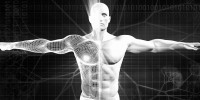
Cancer and Alzheimer’s could be reversed?
The latest paper from Harvard Medical School and collaborators around the world suggests that aging are driven by epigenomic changes, which can be reversed with a reboot. The data supports the Information Theory of Aging, which suggests that a loss of epigenetic information is a reversible cause of aging. If this is correct, one of the authors explains, it means that cancer, diabetes, and Alzheimer's may have the same underlying cause and can be treated or cured with a single treatment. The researchers believe that aging is due to corrupted software, which can be rebooted to restore youth. They show that DNA breaks are a major factor in epigenetic changes we experience in our bodies every day, and that these drive DNA methylation or "Horvath clock." The age-reversal technology is being tested at Life Biosciences in non-human primates to restore vision. Results are expected in a few months.
David A. Sinclair is delighted and says:
 The work represents 13 years of work by 60 people in my lab and around the world.
The work represents 13 years of work by 60 people in my lab and around the world.
Deep dive
What is the current understanding of aging and its causes, and what is the role of epigenetics? Historically, aging has been thought to be caused by a loss of genetic information due to mutations resulting from DNA damage. However, recent research has raised questions about the primacy of mutations as the main driver of aging. Studies have shown that many types of old cells have a paucity of mutations, strains of mice or people with higher mutation rates show little to no evidence of premature aging, and mammals can be cloned from old somatic cells to produce new individuals with normal lifespans.
Rather, is it perhaps the loss of epigenetic information, rather than genetic, that is a possible cause of aging? But why does the epigenome change over time? The loss of transcriptional networks and epigenetic information is driven by a conserved mechanism that evolved to co-regulate responses to cellular damage such as DNA breaks or crush injury.
To test whether epigenetic changes are a cause of mammalian aging, the researchers developed and used a system called “ICE” (inducible changes to the epigenome) to degrade and and also to reset epigenetic information in cells and mice. Their data suggest that aging in mammals is akin to a software problem due to damaged epigenetic information that can be restored using an existing backup copy.
At a glance
Highlights:
The epigenetic landscape erodes through cellular responses to double-stranded DNA breaks.
Aging traits are accelerated by loss of epigenetic information.
These changes can be reversed by epigenetic reprogramming.
We are able to manipulate the epigenome to drive aging both forward and backward.
The researchers used the "ICE" system to show that the act of faithful DNA repair advances aging at physiological, cognitive, and molecular levels, including erosion of the epigenetic landscape, cellular exdifferentiation, senescence, and advancement of the DNA methylation clock. The researchers propose that this process, known as relocalization of chromatin modifiers (RCM), is an example of antagonistic pleiotropy, a process that promotes survival in young individuals but does the opposite later in life. They also suggest that low levels of DNA breaks caused by certain chemical, enzymatic, and radiological agents may promote aging and age-related diseases. However, it is also noted that mammals retain a back-up copy of youthful epigenetic information that can safely restore the function of old tissues.